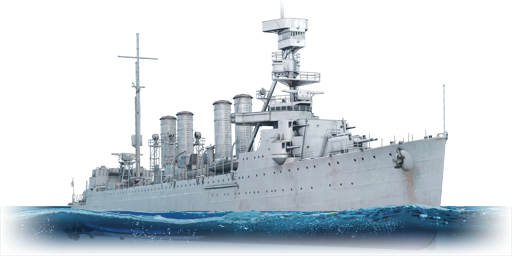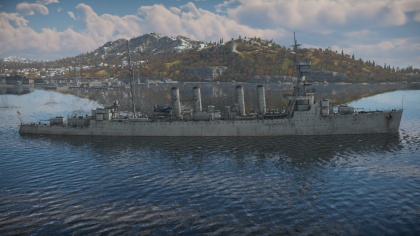Difference between revisions of "USS Trenton"
(Added devblog link and history, Removed nonrelevant armament sections) |
(→Usage in battles) |
||
| Line 37: | Line 37: | ||
''If there is no torpedo armament, remove this section.'' | ''If there is no torpedo armament, remove this section.'' | ||
| − | == Usage in battles == | + | ==Usage in battles== |
''Describe the technique of using this ship, the characteristics of her use in a team and tips on strategy. Abstain from writing an entire guide – don’t get try to provide a single point of view, but give the reader food for thought. Talk about the most dangerous opponents for this vehicle and provide recommendations on fighting them. If necessary, note the specifics of playing with this vehicle in various modes (AB, RB, SB).'' | ''Describe the technique of using this ship, the characteristics of her use in a team and tips on strategy. Abstain from writing an entire guide – don’t get try to provide a single point of view, but give the reader food for thought. Talk about the most dangerous opponents for this vehicle and provide recommendations on fighting them. If necessary, note the specifics of playing with this vehicle in various modes (AB, RB, SB).'' | ||
| − | === Pros and cons === | + | ===Modules=== |
| + | {| class="wikitable" | ||
| + | ! Tier | ||
| + | ! Seakeeping | ||
| + | ! colspan="2"|Unsinkability | ||
| + | ! colspan="3"|Firepower | ||
| + | |- | ||
| + | | I | ||
| + | | Dry-Docking | ||
| + | | Tool Set|| | ||
| + | | 6 inch Mk.27 SC||76 mm AP Mk.29||Anti-Air Armament Targeting | ||
| + | |- | ||
| + | | II | ||
| + | | Rudder Replacement | ||
| + | | Fire Protection System||Smokescreen | ||
| + | | ||76 mm HE-VT||Auxiliary Armament Targeting | ||
| + | |- | ||
| + | | III | ||
| + | | Propeller Replacement | ||
| + | | Ventilation||Shrapnel Protection | ||
| + | | ||Improved Rangefinder||Primary Armament Targeting | ||
| + | |- | ||
| + | | IV | ||
| + | | Engine Maintenance | ||
| + | | New Pumps||Ammo Wetting | ||
| + | | Torpedo Mode|||| | ||
| + | |- | ||
| + | |} | ||
| + | |||
| + | ===Pros and cons=== | ||
''Summarize and briefly evaluate the vehicle in terms of its characteristics and combat effectiveness. Mark its pros and cons in the bulleted list. Try not to use more than 6 points for each of the characteristics. Avoid using categorical definitions such as "bad", "good" and the like - they have a substitution in the form of softer "inadequate", "effective".'' | ''Summarize and briefly evaluate the vehicle in terms of its characteristics and combat effectiveness. Mark its pros and cons in the bulleted list. Try not to use more than 6 points for each of the characteristics. Avoid using categorical definitions such as "bad", "good" and the like - they have a substitution in the form of softer "inadequate", "effective".'' | ||
Revision as of 13:01, 12 June 2019
Contents
Description
The Omaha-class, USS Trenton (CL-11), 1930 is a Rank American light cruiser
with a battle rating of (AB), (RB), and (SB). It was first introduced in Update 1.79 "Project X" during the naval closed beta test.
General info
Survivability and armour
Talk about the vehicle's armour. Note the most well-defended and most vulnerable zones, e.g. the ammo magazine. Evaluate the composition of components and assemblies responsible for movement and manoeuvrability. Evaluate the survivability of the primary and secondary armament separately. Don't forget to mention the size of the crew, which plays an important role in fleet mechanics. Tips for preserving survivability should be saved for the "Use in battle" section.
If necessary, use a graphic template to show the most well-protected or most vulnerable points in the armour.
Mobility
Write about the ship’s mobility. Evaluate its power and manoeuvrability, rudder rerouting speed, stopping speed at full tilt, with its maximum forward speed and reverse speed.
Armament
Primary armament
Provide information about the characteristics of the primary armament. Evaluate their efficacy in battle based on their reload speed, ballistics and the capacity of their shells. Add a link to the main article about the weapon: {{main|Weapon name (calibre)}}.
Broadly describe the ammunition available for the primary armament, and provide recommendations on how to use it and which ammunition to choose.
Secondary armament
Some ships are fitted with weapons of various calibres. Secondary armament is defined by the weapon chosen with the control Select secondary weapon. Evaluate the secondary armament and give advice on how to use them. Describe the ammunition available for the secondary armament. Provide recommendations on how to use them and which ammunition to choose. Remember that anti-air armament, even heavy calibre weapons, belong in the next section.
If there is no secondary armament, remove this section.
Anti-aircraft armament
An important part of the ship’s armament responsible for air raid defense. Anti-aircraft armament is defined by the weapon chosen with the control Select anti-aircraft weapons. Talk about the ship’s anti-air cannons and machine guns, the number of guns and their positions, their effective range, and about their overall effectiveness – including against surface targets.
If there is no anti-aircraft artillery, remove this section.
Torpedo armament
Many ships are armed with torpedo launchers, and for some vessels such as boats, torpedoes are an extremely important means of defeating an opponent. Evaluate the position of the torpedo launchers, discuss the ammunition available, firing specifics such as dead zones, features of the torpedoes themselves, etc.
If there is no torpedo armament, remove this section.
Usage in battles
Describe the technique of using this ship, the characteristics of her use in a team and tips on strategy. Abstain from writing an entire guide – don’t get try to provide a single point of view, but give the reader food for thought. Talk about the most dangerous opponents for this vehicle and provide recommendations on fighting them. If necessary, note the specifics of playing with this vehicle in various modes (AB, RB, SB).
Modules
| Tier | Seakeeping | Unsinkability | Firepower | |||
|---|---|---|---|---|---|---|
| I | Dry-Docking | Tool Set | 6 inch Mk.27 SC | 76 mm AP Mk.29 | Anti-Air Armament Targeting | |
| II | Rudder Replacement | Fire Protection System | Smokescreen | 76 mm HE-VT | Auxiliary Armament Targeting | |
| III | Propeller Replacement | Ventilation | Shrapnel Protection | Improved Rangefinder | Primary Armament Targeting | |
| IV | Engine Maintenance | New Pumps | Ammo Wetting | Torpedo Mode | ||
Pros and cons
Summarize and briefly evaluate the vehicle in terms of its characteristics and combat effectiveness. Mark its pros and cons in the bulleted list. Try not to use more than 6 points for each of the characteristics. Avoid using categorical definitions such as "bad", "good" and the like - they have a substitution in the form of softer "inadequate", "effective".
Pros:
Cons:
History
In the early 1900s leading up to The Great War, conflicting views and opinions on cruiser design among the U.S. Navy’s top brass led to not a single new vessel of this class being laid down. With the outbreak of hostilities in Europe in 1914 and the later involvement of American forces in the conflict, the U.S. Navy had every opportunity to gather the needed experience for creating a new cruiser design.
Thus, during WW1, numerous design propositions for new cruiser variants and subclasses were developed and assessed. In the end, two designs stood out from the rest; a light cruiser with a displacement of up to 8,000 tons and a heavier battlecruiser weighing up to 46,000 tons. The former of the two designs resulted in the creation of the Omaha-class light cruisers. Despite receiving the Congress’ approval in 1916, the Omaha-class cruisers weren’t put into production before more than two years worth of significant redesigning was done to the ship.
The lead ship of the class, USS Omaha, was laid down in December 1918 followed by 9 further ships of the class seeing completion by 1924. Among her sister ships was also USS Trenton (CL-11), the 8th ship of the class, launched in spring 1923. Trenton, like many American warships of the time, travelled a lot around the globe prior to the outbreak of WW2. She frequently took part in fleet exercises, patrols and maneuvers in the Atlantic and Pacific, whilst also paying visits to several Mediterranean ports. During the Spanish Civil War, Trenton was also involved in evacuating American citizens from the country as part of a smaller squadron.
During WW2, Trenton and her sister ships were already starting to show their age despite being upgraded several times. Therefore, ships of this class were primarily relegated to theaters where enemy opposition was estimated to be minimal and were assigned with less vital missions such as patrol duties and occasional shoreline bombardements. As such, no Omaha-class cruiser was ever lost in combat, though some were severely damaged, such as USS Raleigh during the Pearl Harbor raid. In the end, all ships of the Omaha-class were decommissioned after the end of WW2 and were subsequently sold for scrap by the late 1940s.
- From Devblog
Media
An excellent addition to the article will be video guides, as well as screenshots from the game and photos.
See also
Links to the articles on the War Thunder Wiki that you think will be useful for the reader, for example:
- reference to the series of the ship;
- links to approximate analogues of other nations and research trees.
External links
| USA light cruisers | |
|---|---|
| Omaha-class | USS Detroit · USS Raleigh · USS Trenton |
| Atlanta-class | USS Atlanta |
| Brooklyn-class | USS Brooklyn · USS Helena |
| Cleveland-class | USS Cleveland |
| Fargo-class | USS Fargo |
| Worcester-class | USS Roanoke |





